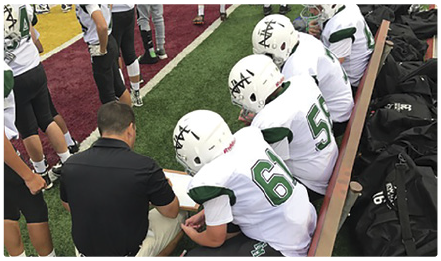Mar 5, 2018Middle School Coverage
 Many high schools partner with hospitals to provide athletic training coverage for their sports teams, but the North Kansas City (Mo.) School District (NKCSD) has taken their arrangement one step further. Starting last fall, NKCSD expanded its existing contract with Mosaic Life Care to bring athletic trainers to its middle schools. Not only is this keeping young students safer, it has laid the groundwork for their athletic futures.
Many high schools partner with hospitals to provide athletic training coverage for their sports teams, but the North Kansas City (Mo.) School District (NKCSD) has taken their arrangement one step further. Starting last fall, NKCSD expanded its existing contract with Mosaic Life Care to bring athletic trainers to its middle schools. Not only is this keeping young students safer, it has laid the groundwork for their athletic futures.
“When the middle school athletes get to high school, they will already know what the athletic trainer is there for, which will keep a lot of injuries from slipping though the cracks,” says Tony Phillips, DC, Director of Sports Medicine at Mosaic Life Care. “In the past, we’ve spent a lot of time educating the freshmen and sophomores on how to use the athletic trainers. Now the transition will be much smoother.”
The idea arose when NKCSD began planning to add football to its middle school programs for 2017-18. Fred Bouchard, Executive Director of Support Services and Athletics for NKCSD, approached Phillips about the need for athletic training coverage for these young athletes.
“At first the school board suggested having athletic trainers cover just the football games,” says Phillips. “But I explained that it would be better to have an athletic trainer fully engaged with the program. The school district has always been open to any idea we throw at them. If it means better care for their kids, they’re all in.”
As a result, Mosaic now provides two full-time athletic trainers, each costing NKCSD $15,000, who rotate between four middle schools. With the schools in close proximity, an athletic trainer can quickly reach an injured athlete. It also helps that many of the middle school competitions are held at the four high school campuses, each of which has a Mosaic athletic trainer on hand.
While most of the sports medicine procedures done at the high school level have simply been replicated at the middle schools, Phillips says there are a few differences, the biggest being parental involvement. At the high schools, athletic trainers typically communicate directly with the coaches and then expect them to pass on information to the parents. But at the middle schools, it became clear that a different method was needed. Instead, the athletic trainers talk to the parents first and then relay the same information to the coaches.
The program has been successful, and Phillips has plans to make it even more effective in the future. “The traditional model is to engage the athlete once they get hurt,” he says. “But that usually involves only 20 percent of the athletes within a school. The problem is that 80 percent are not interacting with the athletic trainers. My goal is to have us do a functional assessment on every athlete, with the idea of engaging not only the 20 percent that get hurt but also the 80 percent that don’t. We believe this can help prevent injuries by identifying weaknesses that athletes should be correcting anyway.”
This article appeared in the March 2018 issue of Training & Conditioning.



